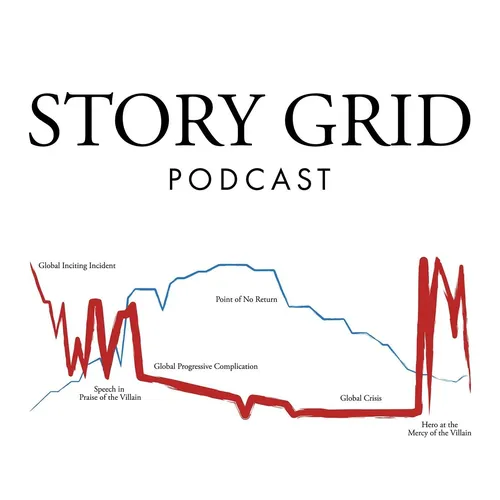
Story Grid Writing Podcast
Helping you become a better writer.
Join Shawn Coyne, author of Story Grid and a top editor for 30+ years, and Tim Grahl, struggling writer, as they discuss the ins and outs of what makes a story great.
More at www.StoryGrid.com.
- Update frequency
- every 5 days
- Average duration
- 47 minutes
- Episodes
- 292
- Years Active
- 2015 - 2023

The Final Episode
This will be the final episode of the Story Grid Podcast for the foreseeable future. Tim gives some background on why this decision was made along with an update on his current writing project and ot…

Crazy Rich Asians: Part 4 - What Writers Can Learn
Access the full Story Grid analysis of Crazy Rich Asians at https://storygrid.com/crazy.
What can writers learn from studying this 2018 film?
This is the final in a four part series analyzing Crazy Ric…

Crazy Rich Asians: Part 3 - Genre Conventions and Story Theme
Access the full Story Grid analysis of Crazy Rich Asians at https://storygrid.com/crazy.
What can writers learn from studying this 2018 film?
This is the second in a four part series analyzing Crazy Ri…

Crazy Rich Asians: Part 2 - 5 Commandments of Storytelling
Access the full Story Grid analysis of Crazy Rich Asians at https://storygrid.com/crazy.
What can writers learn from studying this 2018 film?
This is the first in a four part series analyzing Crazy Ric…

Crazy Rich Asians: Part 1 - Is this a RomCom?
Access the full Story Grid analysis of Crazy Rich Asians at https://storygrid.com/crazy.
What can writers learn from studying this 2018 film?
This is the first in a four part series analyzing Crazy Ric…

John Wick Analysis: Part 4 - What Writers Can Learn and Obligatory Moments
Access the full Story Grid analysis of John Wick at https://storygrid.com/wick.
This is the final in a four part series analyzing the movie John Wick using the Story Grid methodology. This 2014 movie,…

John Wick Analysis: Part 3 - Genre Conventions and Five Commandments
Access the full Story Grid analysis of John Wick at https://storygrid.com/wick.
This is the third in a four part series analyzing the movie John Wick using the Story Grid methodology. This 2014 movie,…

John Wick Analysis: Part 2 - Acts and Structure
Access the full Story Grid analysis of John Wick at https://storygrid.com/wick.
This is the second in a four part series analyzing the movie John Wick using the Story Grid methodology. This 2014 movie…

John Wick Analysis: Part 1 - Genre and Controlling Idea
Access the full Story Grid analysis of John Wick at https://storygrid.com/wick.
This is the first in a four part series analyzing the movie John Wick using the Story Grid methodology. This 2014 movie,…

Line Edits: Putting the Final Touches on Eye Witness
We're down to line edits on Tim's iteration of the masterwork Eye Witness by Ed McBain.
Shawn, Danielle, and Leslie provide final feedback on how to clean up the last few error messages still coming t…

Final Edits of a Short Story: Beat Construction and 624 Analysis
Now that Tim has had a breakthrough on his iteration of EYE WITNESS by Ed McBain, we're getting down to fixing individual Beats and checking to make sure he's adhered to the Story Grid 624 Analysis.
Y…

Does Tim Actually Get It Right? How to Nail the Narrative Device
Does Tim Actually Get It Right? How to Nail the Narrative Device
On Tim's 10th draft, he finally makes a breakthrough on his iteration of EYE WITNESS by Ed McBain!
And it ended up being a simple practi…

How to Connect with Characters: Finding the Motivation and Shadow in Yourself
In this impromptu episode, Tim and Danielle discuss the ongoing problems with the work on the Ed McBain EYE WITNESS scene and why Tim can't connect with his characters.

Writing or Just Pretending? When there is Zero Flow and Everything is $h*t
Shawn takes a crack at rewriting Tim's scene to help him understand what he's missing on the Narrative Device.
Then we hear Leslie and Danielle's edits and feedback on what he got right and wrong.
When…

Conflict and Emotional Connection: Every Beat, Trope, and Scene Must Have These
There are lots of insights in this week's episode of the podcast.
We look at the emotional connection between the hero and victim, ensuring there is conflict at every level of the story, and how bette…

Who's the Most Guilty Person in Your Story? Hero, Victim, and Villain - Part 2
Nobody is innocent in your story. Everyone is hiding something.
You must adjust these levels correctly in order for your reader to connect with the right characters.
This is the focus Danielle, Leslie,…

Hero, Victim and Perpetrator: The Must-Have Relationships in Your Story
Who is the Hero, Victim, and Perpetrator in your story?
What are the relationships between each of them?
The more vague or ungrounded each of these relationships are, the more the story will not read a…

The Impact of a Story Theme: An Interview with Scott Mann and Randle Surles about the book Operation Pineapple Express
Figuring out your Story Theme is the key to unlocking the entire roadmap of your story.
Scott Mann is the author of the new book → Operation Pineapple Express: The Incredible Story of a Group of Ameri…

Truth in Fiction: How to Write and Develop Believable Characters
How do you ground your characters in a reality that your reader will believe even though you are making the whole thing up?
This week Tim makes the mistake of sterilizing his protagonist to the point …

Narrative Device: This Affects Every Single Word You Write
Who is telling your story? Who are they telling it to? Why are they telling it?
This is the Narrative Device!
The Narrative Device consists of three main components:
- Author: The Author is someone who is…